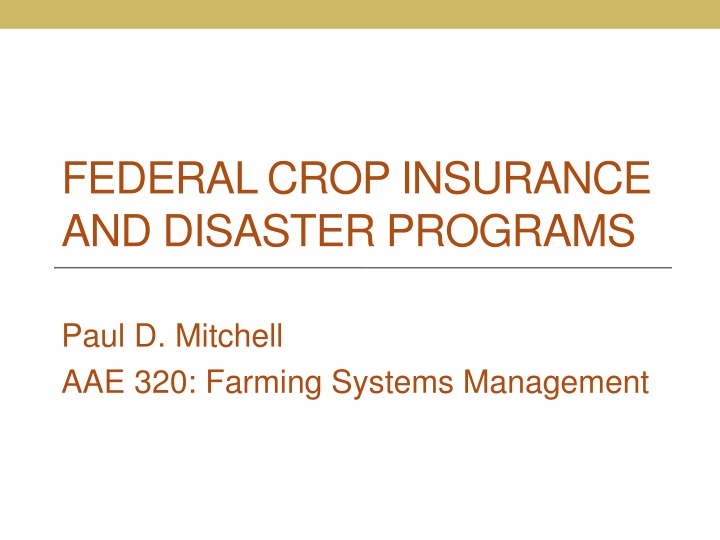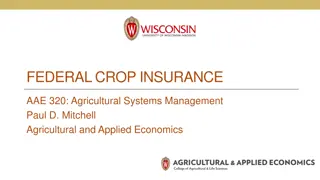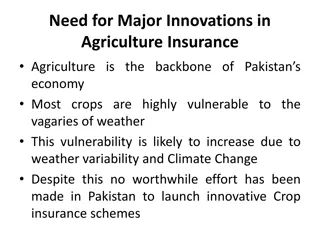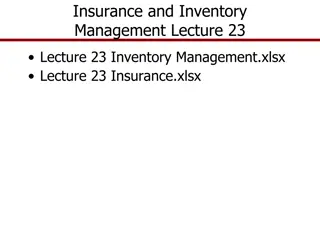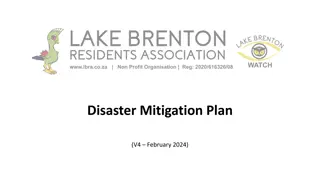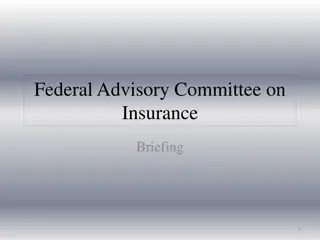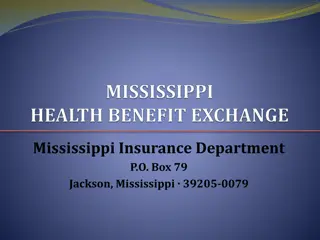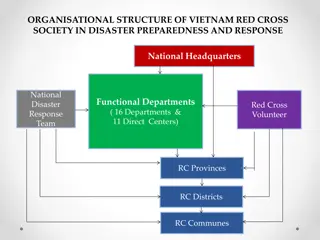Federal Crop Insurance and Disaster Programs Overview
Overview of current crop insurance and disaster programs in the US agricultural sector, detailing the functioning of crop insurance programs, emphasis on crop insurance over disaster programs, commodity support, trends in Wisconsin crop insurance participation, comparison with neighboring states, historical data on insured acres, and guidance for individuals interested in crop insurance. The content covers types of crop insurance policies available, factors influencing payment triggers, and decisions farmers must make when selecting policies.
Uploaded on Sep 21, 2024 | 4 Views
Download Presentation

Please find below an Image/Link to download the presentation.
The content on the website is provided AS IS for your information and personal use only. It may not be sold, licensed, or shared on other websites without obtaining consent from the author.If you encounter any issues during the download, it is possible that the publisher has removed the file from their server.
You are allowed to download the files provided on this website for personal or commercial use, subject to the condition that they are used lawfully. All files are the property of their respective owners.
The content on the website is provided AS IS for your information and personal use only. It may not be sold, licensed, or shared on other websites without obtaining consent from the author.
E N D
Presentation Transcript
FEDERAL CROP INSURANCE AND DISASTER PROGRAMS Paul D. Mitchell AAE 320: Farming Systems Management
Goal Overview current crop insurance programs for major crops How they work, choices farmer must make Disaster Programs were part of the Farm Bill, but crop insurance has become the emphasis
Commodity Support = Farm Safety Net Annual Average 2014-18 $6.1 Billion 2018 Forecast $7.2 Billion Program Crop Insurance Commodity Support & Disaster Aid Conservation $7.2 Billion $8.9 Billion $4.9 Billion $5.6 Billion Commodity Program ARC PLC MAL Dairy Disaster Aid 2018 Forecast 4,755 Million 3,721 Million 63 Million 33 Million 348 Million Crop insurance and two programs (ARC & PLC) dominate commodity support for US farmers
Trends in WI Crop Insurance Participation 85% Corn Soybeans 80% % Planted Acres Insured 75% 70% Corn and soybeans have averaged 76% and 79% respectively for the last 3-4 years 65% 60% 2006 2007 2008 2009 2010 2011 2012 2013 2014 2015 2016 2017 2018
WI vs. neighboring states % planted acres insured in 2013 State IA IL MN MI WI Corn 97% 87% 94% 74% 78% Soybeans 94% 83% 98% 75% 82% Wheat 27% 69% 95% 65% 60% Historically WI was a low participation state, until recently
Crop Insurance Suppose I m interested: Where do I start? Contact a crop insurance agent! They all sell exactly the same polices for exactly the same prices, you are buying service Find someone you like to work with For corn and soybeans: Choices you make 1. What policy to buy? 2. What coverage level to chose? 3. What unit structure to use?
Types of Crop Insurance Policies Farmers have four choices for most crops Are exceptions for regionally minor crops Yield Insurance vs Revenue Insurance What triggers a payment? Yield or Revenue below the guarantee? Individual vs. Area-Wide Coverage Whose yield/revenue triggers payment? Your own or your county s?
WI Crop Insurance Policies: Corn & Soybeans Individual (Farm) Area-Wide (County) So Many Options!! YP AYP Yield Yield Protection RP Revenue Protection Area Yield Protection ARP Area Revenue Protection Revenue RP-HPE: Harvest Price Exclusion ARP-HPE w/ Harvest Price Exclusion Catastrophic coverage (CAT): ForYP, AYP AGR-Lite: Insure Schedule F income
WI Crop Insurance Policies: Corn & Soybeans Individual (Farm) Area-Wide (County) So Many Options!! YP AYP Yield Yield Protection RP Revenue Protection Area Yield Protection ARP Area Revenue Protection Revenue RP-HPE: Harvest Price Exclusion ARP-HPE w/ Harvest Price Exclusion Catastrophic coverage (CAT): ForYP, AYP AGR-Lite: Insure Schedule F income
Types of Policies Yield Protection (YP) Individual Yield Insurance Revenue Protection (RP) and RP-HPE (harvest price exclusion) Individual Revenue Insurance Area Yield Protection (AYP) Area-wide (County) Yield Insurance Area Revenue Protection (ARP) and ARP-HPE (harvest price exclusion) Area-wide (County) Revenue Insurance
Farmer Choices After choose a policy (YP, RP, AYP, ARP), then have three choices to make Coverage Level (like the deductible) Price Election (payment rate for losses) Unit Structure (some policies have no options) I will explain Yield Protection details to understand the other policies
YP: Yield Protection If actual harvested yield is less than your Yield Guarantee, receive an indemnity Actual Production History (APH): Average harvested yields over last 4-10 years Yield Guarantee: chose Coverage Level as % of your APH (Actual Production History) Coverage Level: % average yield (APH) chosen as guarantee, from 50% to 85% by 5% intervals Price Election: Choose price paid for each bushel below your yield guarantee, from 100% to 55% of established Base Price
Coverage Level sets Yield Guarantee: Example to Illustrate Coverage Level Yield Guarantee 50% x 155 = 78 bu/ac 55% x 155 = 85 bu/ac 60% x 155 = 93 bu/ac 65% x 155 = 101 bu/ac 70% x 155 = 109 bu/ac 75% x 155 = 116 bu/ac 80% x 155 = 124 bu/ac 85% x 155 = 132 bu/ac Year Yield 2012 165 2013 175 2014 150 2015 110 2016 185 2017 145 AVG 155 APH = 155
Price Election How much you are paid for each bushel that actual harvest is below yield guarantee Base Price set by USDA-RMA: Average of Dec corn (Nov soybean) futures contracts on Chicago Mercantile in Feb Choose 100% to 60% of this price in 1% intervals, appears as $/bu options Most farmers choose 100% Price set for large regions 2014: Corn $4.62, Soybeans $11.36, Wheat $6.51 2015: Corn $4.15, Soybeans $9.73, Wheat $5.85 2016: Corn $3.86, Soybeans $8.85, Wheat $5.13 2017: Corn $3.96, Soybeans $10.19, Wheat $4.74 2018: Corn $3.96, Soybeans $10.16, Wheat $5.02
YP Indemnity If Actual Harvested Yield < Yield Guarantee Indemnity = Price x (Yguarantee Yharvested) Price: Chosen Price Election Most farmers choose 100% Coverage Level determines your trigger, pay more for higher coverage levels Price Election determines how much you are paid when you have a loss, pay more for higher price election
Unit Structure Legally define the area (fields) insured Planted to same crop during insurance period Cannot cut across a county line Separate production records for each unit Three unit types (smallest to largest) Optional Unit, Basic Unit, Enterprise Unit Previous Recommendation: Get as many Optional Units as you can Current Recommendation: Premium discounts have made Enterprise Units often the best deal Lots of rules: Crop insurance agent can help you figure out rules
Unit Structure Choices All guarantees at the unit level, not on a per acre basis 100 acre unit, average yield 160 bu/ac, 75% coverage level = 100 x 160 x 0.75 = 12,000 bushels Guaranteed 12,000 bu from those 100 acres Have to choose how to combine fields together into units Can t just combine fields any way you want: Rules to follow Unit Sizes (smallest to largest): Optional < Basic < Enterprise Smaller units means more indemnities (averaging over smaller area) and so larger premiums Government encourages larger units by giving larger premium subsidies for larger units (enterprise unit discount)
Farms A-G: Same operator planting the same crop Basic Units (1) A, C, D, and F Farm B 50-50 crop share lease from Smith Farm D cash rent from Jones Farm A Owned (2) B and E Township Section 2 (3) G Farm E 50-50 crop share lease from Smith Township Section 1 Farm C cash rent from Smith Optional Units (1) A and C (2) B Farm G 60-40 crop share lease from Black Farm F Owned (3) D (4) E (5) F (6) G Township Section 11 Township Section 12 Enterprise Unit (1) A thru G
Simple YP Example for a Unit Suppose have one unit, 100 acres of corn APH (average yield) is 160 bu/ac Choose 70% coverage level, and 100% price election $5.65/bu Yield guarantee = 70% x 160 bu/ac = 112 bu/ac Unit Guarantee = 112 x 100 ac = 11,200 bushels Actual harvest from Unit is 10,500 bu (or 105 bu/ac) Indemnity: $5.65 x (11,200 10,500) = $3,955 (or $39.55/ac) Notice how guarantee and indemnity work at the unit level, but often talk about it at the per acre level
Revenue Protection Combines Yield Protection with price protection based on CBOT futures prices Your yield history and CBOT prices set your preliminary Revenue Guarantee Same coverage levels, same unit structures Your revenue at harvest is your yield x CBOT prices (e.g., Nov average of Dec corn) If your harvest revenue is below your guarantee, triggers an indemnity payment
Initial and Final Revenue Guarantee RP vs. RP-HPE Base Price: Feb avg of Dec corn futures Harvest Price: Nov avg of Dec corn futures Initial Revenue Guarantee: calculated using the Base Price Final Revenue Guarantee: calculated using the maximum of Base Price and Harvest Price Main Point: With RP, if price increases over season, your revenue guarantee increases RP-Harvest Price Exclusion: revenue guarantee is not updated with max(Base, Harvest) price Lower indemnities with RP-HPE if price increases and have low yield, so Lower Premiums Very few farmers buy RP-HPE
RP Protects Against Both Price Increases and Decreases If price falls or have low yield, you know you will have the grain, or the money to buy grain at existing prices, to fulfill contracts/feed livestock If price increases, revenue guarantee increases too, so again you know you will have the grain, or the money to buy the grain at existing prices, to fulfill contracts/feed livestock Still have to market your grain Can now market more aggressively since you will have grain or indemnities to buy grain at existing market prices if you have a yield loss
Simple Example Comparing the three Assume 150 bu/ac APH and 70% coverage level, so YP: per acre guarantee is 105 bu/ac Base price at plant $5.00, so RP and RP-HPE Initial Guarantee $5.00 x 105 = $525/ac Actual yield is 75 bu/ac, so loss is 105 75 = 30 bu/ac YP pays $5.00 x 30 bu/ac = $150/ac What happens if harvest price increased to $6.00? RP Guarantee $6.00 x 105 bu/ac = $630/ac RP pays: $630 ($6.00 x 75) = $630 $450 = $180/ac RP-HRE: Guarantee not change: $525 $450 = $75/ac What happens if harvest price decreased to $4.00? RP and RP-HRE Guarantees do not change Both pay $525 ($4.00 x 75) = $525 $300 = $225/ac Note: all of these would be at unit level, not per acre
RP vs. RP-HPE vs. YP (150 bu/ac APH and 70% coverage level) Base Price $/bu Gtee $/ac bu/ac $525 Harvest Price $/bu Gtee $/ac bu/ac Actual Yield bu/ac Actual Rev $/ac Indemnity $/ac Policy RP $5.00 $6.00 $630 75 $450 630 450 = $180 525 450 = $75 RP- HPE $5.00 $525 $6.00 $525 75 $450 YP $5.00 105 bu/ac $525 $6.00 105 bu/ac $525 75 $450 $5x(105 - 75) = $150 525 300 = $225 525 300 = $225 RP $5.00 $4.00 75 $300 RP- HPE $5.00 $525 $4.00 $525 75 $300 YP $5.00 105 bu/ac $4.00 105 bu/ac 75 $300 $5x(105 - 75) = $150
RP vs. RP-HPE vs. YP If harvest price > base price and low yield, larger indemnity for RP than for RP-HPE If harvest price < base price, no difference for RP vs RP-HPE Notice: RP-HPE: can do worse than YP if high prices and low yields RP-HPE uses actual higher harvest price to calculate actual revenue, while YP uses actual yield loss at lower base price RP-HPE: worst if low yields and high prices, best if low yields and low prices
Simple RP Example for a Unit Suppose have one unit, 100 acres of corn APH (average yield) is 160 bu/ac Announced Base Price is $3.75 Choose 70% coverage level Initial Revenue Guarantee = 70% x 160 bu/ac x $3.75/bu x 100 ac = $42,000 (or $420/ac) Harvest time price announced as $4.00/bu Final Revenue Guarantee = 70% x 160 bu/ac x $4.00/bu x 100 ac = $44,800 (or $448/ac) Actual harvest from Unit is 10,500 bu (or 105 bu/ac), so actual revenue from Unit = $4.00 x 10,500 = $42,000 Indemnity: $44,800 $42,000 = $2,800 (or $28/ac) Again, guarantee and indemnity work at the unit level, but often talk about it at the per acre level
AYP Area Yield Protection ARP Area Revenue Protection AYP = YP, except uses USDA-NASS county average yield (not your yield) ARP = RP except uses USDA-NASS county average yield ARP-HPE = RP-HPE except uses USDA-NASS county average yield Payments not made until Mar/Apr when USDA- NASS yields come out: cash flow issues?
WI Crop Insurance Policies: Corn & Soybeans Individual (Farm) Area-Wide (County) So Many Options!! YP AYP Yield Yield Protection RP Revenue Protection Area Yield Protection ARP Area Revenue Protection Revenue RP-HPE: Harvest Price Exclusion ARP-HPE w/ Harvest Price Exclusion Catastrophic coverage (CAT): ForYP, AYP AGR-Lite: Insure Schedule F income
% of Insured Corn and Soybean Acres by Policy Type in 2017 in Wisconsin 100% 93% Corn Soybean 87% 90% 80% 95.5% of Corn and 98.0% of Soybean in RP or YP 70% 60% 50% 40% 30% 20% 8% 5% 10% 4% 2% 1% 0% 0% RP YP ARP AYP
Lots of Crop Insurance Rules Lots rules: Planting dates, Late and prevented planting, Double cropping, Alternative crop uses, Corn maturity, Yield guarantees, Unit structures, Breaking new ground (CRP vs pasture) Can forfeit your coverage if break a rule Are ways to get the most out of your policy (use the rules to your advantage) Insurance agents don t always know all the rules, but good agents do
Subsidies and Crop Insurance USDA-RMA runs crop insurance program, sets policy rules, sets premiums Premiums subsidized so farmers pay less than the actuarially fair premium If on average, $100 indemnity paid once every 4 years, then actuarially fair premium is $25 Private companies sell insurance policies, but government subsidizes their administrative costs No premium load to cover costs All companies sell exactly the same policies at the same prices Means that on average, farmers should make money from crop insurance
Premiums Subsidized: For RP and YP, % of the Fair Premium Farmers Pay Coverage Level 50% 55% 60% 65% 70% 75% 80% 85% Optional Units 33% 36% 36% 41% 41% 45% 52% 62% Basic Units 33% 36% 36% 41% 41% 45% 52% 62% Enterprise Units 20% 20% 20% 20% 20% 23% 32% 47%
Premiums Subsidized: For AYP and ARP, % of Fair Premium Farmers Pay Coverage Level 70% 75% 80% 85% 90% AYP 41% 41% 45% 45% 49% ARP 41% 41% 45% 51% 56% Main point: Government and farmers share the premium cost Higher coverage, farmer pays greater share CAT: 100% subsidized, just pay $300 admin fee
Premiums ($/A): Dane County WI, 2018 (165 Trend Adjusted APH) Yield Protection Coverage Enterprise 50% 55% 60% 65% 70% 75% 80% 85% Basic 1.66 2.53 3.38 5.08 6.86 9.65 15.43 22.67 Optional Guarantee 2.55 3.79 4.98 7.36 9.74 13.5 21.16 30.58 1.01 1.41 1.88 2.48 3.34 4.93 9.24 16.72 82 bu 91 bu 99 bu 107 bu 115 bu 124 bu 132 bu 140 bu
Premiums ($/A): Dane County WI, 2018 (165 Trend Adjusted APH) Revenue Protection Coverage Enterprise 50% 55% 60% 65% 70% 75% 80% 85% Basic Optional Initial Guarantee 2.00 3.13 3.25 4.79 4.46 6.39 6.92 9.54 9.53 12.75 13.66 17.88 21.76 27.76 32.36 40.44 1.21 1.78 2.32 3.16 4.47 6.81 12.56 23.02 $327/A $359/A $392/A $424/A $457/A $490/A $522/A $555/A
Premiums ($/A): Dane County WI, 2018 (165 Trend Adjusted APH) Revenue Protection-HPE Coverage Enterprise 50% 55% 60% 65% 70% 75% 80% 85% Basic 1.52 2.4 3.31 5.21 7.24 10.32 16.62 24.78 Optional 2.41 3.71 4.99 7.53 10.06 14.08 22.21 32.42 Guarantee $327/A $359/A $392/A $424/A $457/A $490/A $522/A $555/A 0.92 1.3 1.68 2.33 3.35 5.1 9.39 17.27
Compare 2018 Policy Prices (Optional Units) in Dane County 45 RP RP-HPE YP 40 35 Premium ($/A) 30 25 20 15 10 5 0 50% 55% 60% 65% Coverage Level 70% 75% 80% 85%
Revenue Protection Farmer Premiums in 2018 Dane County, WI 165 bu/A Yield, $3.96/bu Base Price 45 Enterprise Basic Optional 40 35 Premium ($/A) 30 25 20 15 10 5 0 50% 55% 60% 65% 70% 75% 80% 85% Coverage Level
WI Farmers Practices and Experiences with Crop Insurance Quick overview of WI farmer practices Which policies popular Which coverage levels Quick overview of WI farmer experiences What are loss ratios Farmer Loss Ratios for corn and soybeans
What policies do WI farmers buy? CORN: % insured acres under each policy Year 2009 2010 2011 2012 2013 2014 SOYBEAN: % insured acres under each policy RP YP Other 69% 71% 76% 81% 84% 85% 22% 21% 16% 14% 11% 9% 9% 8% 7% 4% 6% 6% Year 2009 2010 2011 2012 2013 2014 RP YP Other 77% 82% 84% 88% 91% 92% 16% 13% 11% 10% 8% 6% 8% 5% 4% 1% 1% 2%
Coverage Levels used by WI farmers for RP and YP in 2012 for Corn and Soybeans Coverage Level CAT 50% 55% 60% 65% 70% 75% 80% 85% Corn RP Soy RP Corn YP --- --- 1% 1% 0% 0% 3% 2% 6% 5% 28% 24% 38% 43% 20% 21% 4% 4% Soy YP 40% 7% 2% 6% 15% 21% 8% 2% 0% 43% 7% 1% 6% 15% 22% 6% 1% 0%
Coverage Levels used by WI farmers for RP and YP in 2012 for Corn and Soybeans Coverage Level CAT 50% 55% 60% 65% 70% 75% 80% 85% Corn RP Soy RP Corn YP --- --- 1% 1% 0% 0% 3% 2% 6% 5% 28% 24% 38% 43% 20% 21% 4% 4% 88% Soy YP 40% 7% 2% 6% 15% 21% 8% 2% 0% 43% 7% 1% 6% 15% 22% 6% 1% 0% 60%-65% of all WI corn and soybean acres have RP with a 70% to 80% coverage level 86%
Average Number of Units per Policy in WI Year CORN RP CORN YP 2009 2.32 2.11 2010 2.13 2.08 2011 3.51 2.14 2012 3.52 2.22 2013 3.31 2.23 2014 3.26 2.29 SOY RP 2.04 1.89 2.80 2.81 1.90 2.66 SOY YP 1.84 1.71 1.77 1.86 1.86 1.74 WI farmers using RP are using more Optional Units WI farmers using YP: no unit changes, using Basic Units
WI Farmers and Crop Insurance About 75%-80% of WI corn and soybean acres are insured 60% to 65% of WI corn and soybean acres use Revenue Protection (RP) 70%-80% Coverage Level Optional Units Smaller group of insured corn and soybean farmers use Yield Protection (YP) Catastrophic policy (CAT) Basic Units More recently, many farmers have been using Enterprise Units due to the cost savings
Crop Insurance Subsidies Administered by USDA-Risk Management Agency (RMA) and Federal Crop Insurance Corporation (FCIC) USDA develops policies, rules, and premium rates Development & administration costs paid by the public USDA subsidizes the premiums Farmers pay about of fair premiums on average USDA pays subsidy to companies for Administration and Operating (A&O) ~20-25% of total premiums FCIC reinsures the insurance companies, plus retains some of the policies Means FCIC pays some of the indemnities
Main Point Crop insurance has become the core of commodity support from the federal government Most acres insured and most subsidies from crop insurance Why crop insurance is popular in Congress Market-based, not government run program Farmers share in cost of program Farmers receive payments only when have demonstrated losses Public-private partnership btwn government & insurance companies, who both bear some of the risk & costs Historically, program has been financially solid
Crop Insurance for Other Crops Almost all major WI crops have a standard crop insurance policy for them, usually YP Forage production and seeding Small Grains: oats, rye, barley Processing Vegetables: Potatoes, sweet corn, snap beans, green peas Miscellaneous crops: Cranberries, hybrid seed corn, mint, apples
Crop Insurance Alternatives AGR-Lite: Insure farm s Schedule F income Multiple crops & livestock, allows insuring whole farm revenue Alternatives if no policy exists FSA non-insured crop assistance program (NAP policy): FSA sells CAT policy if none available Written Agreement: apply RMA policy from a similar area to your crop (e.g., grapes in MI for WI) Organic prices now available for many crops Corn, soybeans, wheat, etc. Livestock price (not production) policies LGM Dairy was somewhat popular, but new MPP killed it? Pasture Rangeland Forage: weather station rainfall & temps
Dairy Revenue Protection New in the fall of 2018 Insure Dairy Revenue (not margin like LGM Dairy, MPP) Uses futures prices and production data to create revenue guarantee, with payments triggered when actual market prices fall below the guarantee Can choose two pricing options: mix of class III/IV or component prices (fat, protein, other solids), where you can choose the price weights Can cover up to 5 quarters into the future (depending on futures price data) More information: it is new and hot, but hard to find clear information and recommendations just yet (next year!)
